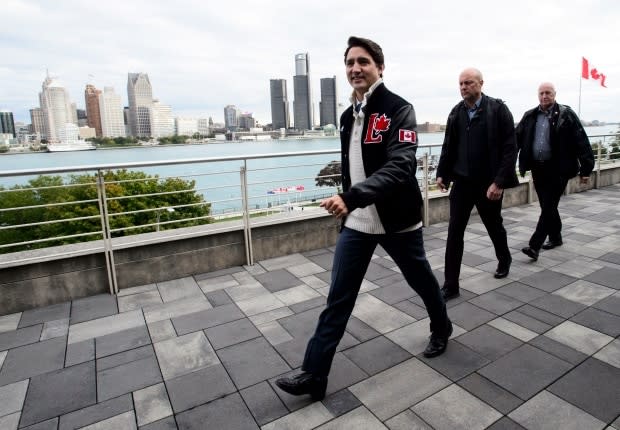Canada needs an infrastructure overhaul. Can any federal party get it done?
Infrastructure spending is an easy source of election campaign fodder — and the current campaign has seen no shortage of ambitious promises to build, subsidize or repair.
The Liberals are offering an additional $3 billion annually in permanent transit funding. The Conservatives want an east-west energy corridor. The New Democrats are promising 500,000 new affordable homes in 10 years, while the Greens want to retrofit every building in Canada to optimize energy use. And that's not even an exhaustive list.
But recent history suggests that realizing those lofty commitments could be difficult, even for a majority government with budgetary breathing room.
Developments on the campaign trail this week help to explain why it's so difficult to get infrastructure projects done in Canada.
In a Wednesday statement, the Liberals promised federal funding for a new $11-billion transit line in Toronto if they form the next government. But making that promise required some very careful messaging — since the project is the brainchild of Ontario's Progressive Conservative government and, until yesterday, Liberal MPs from the area had spent most of this year mocking it.
When the project was proposed by Ontario Premier Doug Ford in April, it sparked political chaos. Many Toronto officials initially opposed it, exacerbating existing tension between the city and province.
Seizing on that strife, the Liberals dragged their heels on federal funding as they feuded public with the Ontario government on several other issues, including the carbon levy.
'Politicians have become involved not just in the decision making but also in the evidence making.' - Matti Siemiatycki, U of T associate professor
In short, it was a pretty big mess, with all three levels of government locked in a politically-charged standoff while Toronto transit riders suffered.
But the Ford government and the City of Toronto recently reached a compromise, and the project looks set to move ahead. With local resistance nullified, the Liberals were left with little choice but to promise federal funds.
'Mixed record'
This saga illustrates why big infrastructure promises should be received with cautious optimism, said Murtaza Haider, an associate professor at the Ted Rogers School of Management at Ryerson University.
"There is only one taxpayer but there are three tax collectors. That creates a unique set of circumstances, and often the tax collectors can't come to terms or agree on how they should spend that money," he said.
Even with a federal government committed to pushing infrastructure projects through, it's hard to be sure which projects will be completed.

Take the last four years, for example. Infrastructure spending was central to Liberal Leader Justin Trudeau's 2015 election pitch. More money for transit, roads, bridges and waterworks would get a stagnant economy moving again, he said at the time.
Some parts of the plan materialized. The Trudeau government earmarked $188 billion over 12 years for projects throughout the country. New construction and upgrades helped move the needle several percentage points on what was nearly flat growth when the Liberals took power.
The government also made considerable changes to the transit funding model that eased the financial burden on municipalities, allowing some priority projects to move forward.
But there were also difficulties on some fronts.
Despite Trudeau's commitments, his mandate ended with a "mixed record" on delivering infrastructure funding, said Matti Siemiatycki, an associate professor of geography and planning at the University of Toronto.
"There's been a lot of spending but it's been slower, in many cases, than what was expected," he said.
Political meddling
The Parliamentary Budget Officer said as much in a March report. The PBO concluded that in the last two years, Ottawa spent only 60 per cent of its allocated infrastructure budget — a figure Conservatives have been eager to mention during the campaign.
Then there is the $35-billion Canada Infrastructure Bank established by the Trudeau Liberals. As of this summer, the bank had invested in fewer than five projects across the country. Both the Tories and NDP have said they would scrap the bank.
But that sluggishness is in large part due to political meddling in the infrastructure planning process at the municipal and provincial levels — something that seems to have intensified in recent decades, Siemiatycki said.
"The challenge that we've faced across the country is that politicians have become involved not just in the decision making but also in the evidence making," he said.
"They have become deeply engaged in how the studies get done and how the technical evidence is compiled to justify decisions."
Given the bottom-up nature of infrastructure planning in Canada (provinces, territories and municipalities own 98 per cent of the country's infrastructure assets), the federal government can do little to fix the situation.
For his part, Conservative Leader Andrew Scheer has said a government led by him would streamline the planning process by prioritizing projects that are in the national interest and cut down on commute times.
The Conservative platform, however, includes an $18-billion cut to infrastructure spending and pushes the allocation timeline out to 12 years instead of 10.

Bill Karsten, president of the Federation of Canadian Municipalities (FCM) and a Halifax city councillor, said the Conservative infrastructure plan "has a critical lack of detail."
"There are fundamental questions left unanswered," he said.
However it gets done, though, it's clear that infrastructure dollars need to start flowing more efficiently.
The 2019 Canadian Infrastructure Report Card — a report compiled by several national groups, including the FCM — concluded that a "concerning amount of municipal infrastructure is in poor or very poor condition."
It adds that growth in major population centres has far outpaced capital investment in the kinds of infrastructure projects that generally make urban life more liveable. And many rural municipalities are too focused on maintaining existing assets to look at building new ones.

